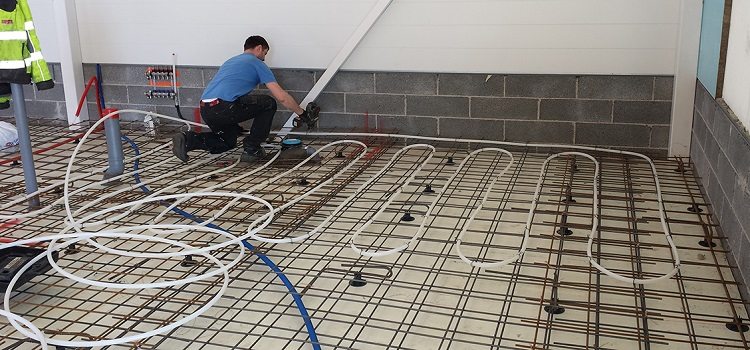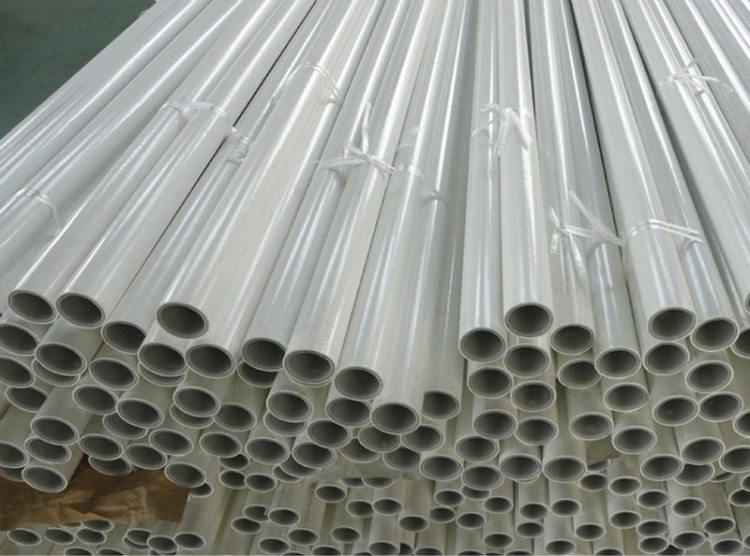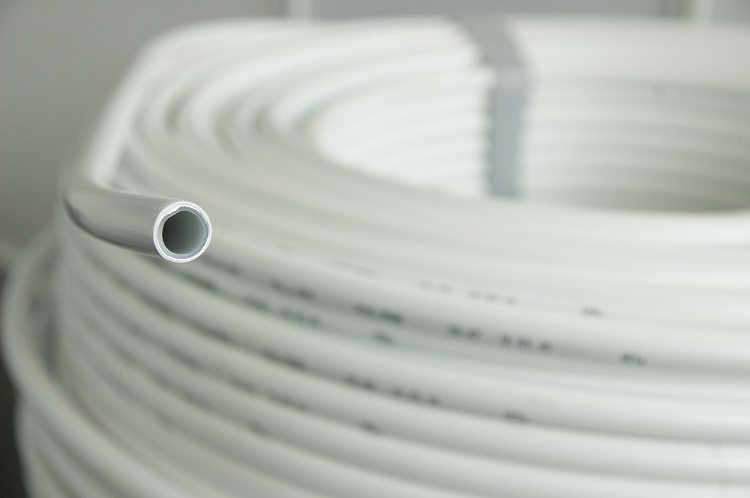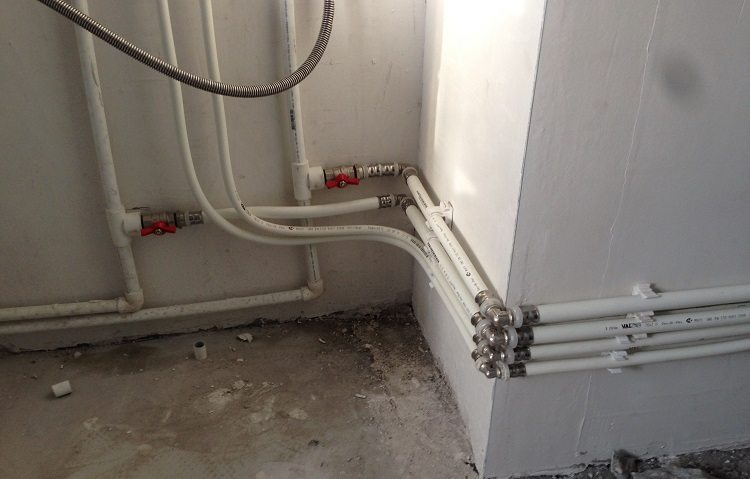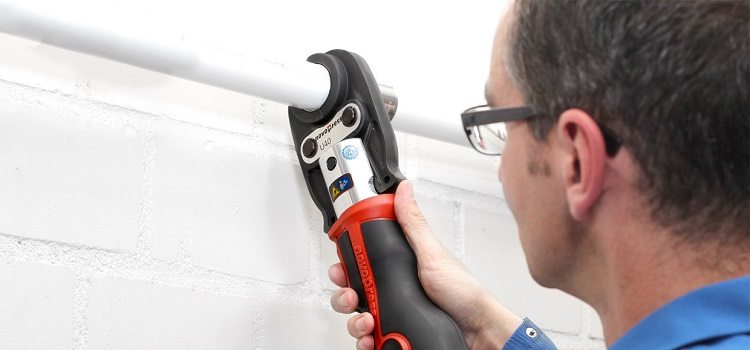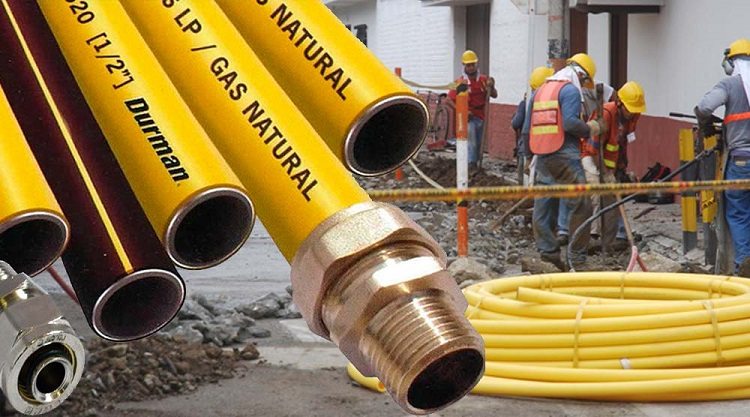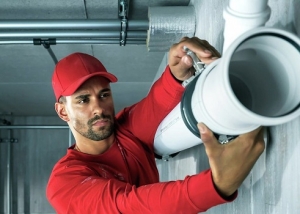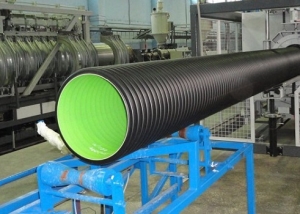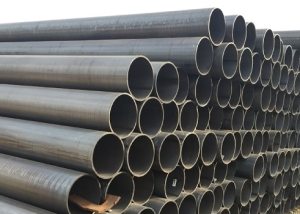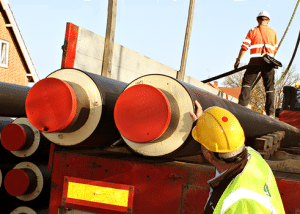Metal-plastic pipes perfectly combine the strength characteristics of metal and the advantages of plastic. Due to this, they are widely used for the transfer of water and other liquid media, gas. Particular attention is paid to the advantageous characteristics of the pipes. Metal-plastic is a multilayer structure that determines the operational parameters of products. The sizes of metal-plastic pipes are very diverse, so usually there are no difficulties with the choice.
Content
- 1 Production of metal-plastic pipes for water supply
- 2 Pipe advantages
- 3 Variety of product diameters and sizes
- 4 Deviations in the size of plastic pipes
- 5 Technical Parameters of Water Products
- 6 Utilities for water
- 7 Features to consider during installation
- 8 Metal-plastic pipes for gas transport
- 9 Subtleties of marking pipes
Production of metal-plastic pipes for water supply
The characteristics of a metal-plastic pipe for water (or gas) are determined by their structure and features of the production process. As polymer layers, either cross-linked polyethylene or high-temperature-resistant polyethylene can be used. At the initial stage, the raw material is loaded into the extruder, heated and compacted. Here, a catalyst is added to the crosslinked polyethylene.
Then, through a special form, the inner shell of the future metal-plastic pipe is extruded for the water supply system. After waiting for the hardening time, a layer of aluminum foil is attached to the polymer surface using heat-resistant glue. It is lapped or butt welded by laser welding. Then a layer of glue is again applied to the foil to fix the outer shell of polyethylene. At the final stage plastic pipes undergo pressure testing in a calibration machine.
The presence of foil provides products for the transport of hot water with a low value of linear expansion, the absence of vapor transmission. Its heat-insulating properties prevent the formation of condensate on the plastic pipe. For water pipes, product diameters can be very different and are regulated by product standards.
Pipe advantages
Metalloplast is characterized by absolute resistance to corrosion processes. This property is important when transporting water, when the product is constantly in direct contact with it.
In addition, plastic pipes are characterized by high throughput, which is achieved by the smoothness of the inner coating. Usually this layer is represented by high density polyethylene, capable of not losing properties when exposed to hot water.
Note! If a metal-plastic pipe is connected to a metal section, it is recommended to install special filters at the joints. Such a solution will prevent the ingress of rust or other debris from the old water supply system into the new one.
The aluminum layer of products provides good strength characteristics, which far exceed the similar values of polyethylene or polypropylene models. Metal-plastic pipes are resistant to high temperatures, therefore, based on them, it is possible to organize a heating system and a hot water supply network.Other important advantages of such products are environmental cleanliness, lightness and affordability.
Variety of product diameters and sizes
There is a wide variety of pipe diameters (metal-plastic). For the organization of the water supply, models with a section of 15-50 are most often used, for sewage - 32-150 millimeters. The diameter of the plastic pipes on the marking can be expressed in inches (1 inch is 25.4 mm).
However, in practice, the following relationships are true. They are presented in the table.
Table 1
| Inches | ½ | ¾ | 1 | 1 ¼ | 1 1/2 | 2 | 3 | 4 | 6 |
| Millimeters * 10 | 1,5 | 2,0 | 2,5 | 3,2 | 4,0 | 5,0 | 8,0 | 10,0 | 15,0 |
Based on the table, you can choose the required or closest to the existing parameter size. The inch designation includes a numeric value and a double stroke.
Note! When choosing the right product, it is better to navigate through the internal section.
The diameters of the plastic pipe according to the standard 53630-2009 are given in table No. 2.
table 2
| The nominal value of the outer diameter, * 102 mm | Outer diameter mm | The minimum value of the inner diameter, * 10 mm |
| 0,14 | 14 | 1,0 |
| 0,16 | 16/17 | 1,1 |
| 0,20 | 18/20 | 1,4 |
| 0,25 | 25/26 | 2,0 |
| 0,32 | 32 | 2,5 |
| 0,40 | 40 | 3,2 |
| 0,50 | 50 | 4,0 |
| 0,63 | 63 | 5,0 |
| 0,75 | 75 | 6,0 |
| 0,90 | 90 | 7,3 |
| 1,10 | 110 | 9,0 |
Deviations in the size of plastic pipes
The normative document sets the values of deviations of the main dimensions of metal-plastic pipes for water (hot). The relevant indicators are given in table No. 3.
Table 3
| Outer diameter mm | Wall deviation, * 10 mm | Product length in a bay or segments | ||
| Nominal value, * 10 | Maximum deviation, * 102 | Nominal value, no more, m | Maximum deviation, * 10-1 % | |
| 1,4 | +0,003 | +0,015 -0,01 |
200/5 | 5 |
| 1,6 | +0,003 | +0,015 -0,01 |
||
| 2,0 | +0,003 | +0,015 -0,01 |
||
| 2,5 | +0,003 | +0,02 -0,01 |
up to 100/5 | |
| 3,2 | +0,003 | ±0,02 | up to 50/5 | |
| 4,0 | +0,003 | ±0,02 | until 25/5 | |
| 5,0 | +0,003 | ±0,02 | ||
| 6,3 | +0,003 | ±0,02 | until 15/5 | |
| 7,5 | +0,003 | ±0,03 | -/5 | |
| 9,0 | +0,003 | ±0,03 | ||
| 11,0 | +0,004 | ±0,03 | ||
Technical Parameters of Water Products
Depending on its size, a metal-plastic pipe can have various technical indicators that must be considered when choosing materials for the installation of networks for various purposes. The table shows some values of the characteristics of products for water and gas.
Table 4
| Outer Diameter * 103 mm | ||||
| 0,016 | 0,020 | 0,026 | 0,032 | 0,040 |
| Diameter inside, * 103 mm | ||||
| 0,012 | 0,016 | 0,020 | 0,026 | 0,033 |
| Weight of one meter of the product, * 10 g | ||||
| 11,5 | 17,0 | 30,0 | 37,0 | 43,0 |
| Wall, * 10-2 mm | ||||
| 200 | 200 | 300 | 300 | 350 |
| The volume of water (liquid medium) in one meter of the product, * 10-3 l | ||||
| 113 | 201 | 314 | 531 | 855 |
| Destructive pressure at 20 degrees, * 10 bar | ||||
| 9,4 | 8,7 | 8,8 | 7,4 | 6,7 |
| Minimum manual bending radius * 10 mm | ||||
| 8,0 | 10,0 | 11,0 | 16,0 | 55,0 |
| Permissible bending radius made by a pipe bender, * 102 mm | ||||
| 0,45 | 0,60 | 0,95 | 1,25 | 1,80 |
| The tensile strength at break (transverse), * 10 N | ||||
| 288,0 | 305,0 | 326,0 | 343,0 | 357,0 |
Common indicators of all diameters of pipes for water are:
- temperature (working) when exposed to a pressure of 10 bar: from 0 to 95 degrees; at 25 bar - from 0 to 25 degrees;
- maximum value of short-term admissible temperature: 130 degrees;
- maximum pressure (operating) at maximum temperature: 10 bar;
- linear expansion: 2.6 * 10-5 1 / ºС;
- roughness: 0.07;
- thermal conductivity: 0.43 W / m * K;
- adhesive strength value: 70 N / 10 mm;
- the value of the bond strength of aluminum by welding: 57 N / mm2;
- operational term: half a century.
Indicators of resistance without failure at a constant internal pressure are given in the table.
Table 5
| Diameter, * 102 mm | 0,16 | 0,20 | 0,26 | 0,32 | 0,40 |
| Within 1 hour at 20 ºС, not less, kPa |
5710 | 5100 | 5430 | 5120 | 4840 |
| Within 1 hour at 95 ºС, not less, kPa |
3300 | 3030 | 3180 | 3030 | 2950 |
| Within 100 hours at 95 ºС, not less, kPa | 2930 | 2690 | 2830 | 2700 | 2620 |
| Within 1000 hours at 95 ºС, not less, kPa | 2570 | 2360 | 2520 | 2440 | 2310 |
Utilities for water
The scope of the communications in question is any engineering network - wiring hot, cold water, heating, etc. However, it is important to remember that metal-plastic pipes should not be used in open systems. Freezing the transported medium can damage the product.
Pipe connection, both for hot water and gas, is performed by crimping or press fittings. System installation includes cutting products using special scissors, deburring from the ends, calibration and directly fitting connection.
It is necessary to apply silicone grease to the fitting of the docking element, and to put on a pipe nut and a compression ring on the pipe. Next, the product is carefully mounted on the fitting fitting and with two wrenches, the nut is securely fixed.
The connecting elements must not be hidden in the screed, walls, cast concrete, floor. For testing, the assembled system is pressure tested, which is 1.5 times higher than the rated load.
Features to consider during installation
Plastic pipes are not without some drawbacks. Firstly, the metal and polymer that make up such communications have different expansion coefficients. For this reason, constant temperature differences in the liquid medium can weaken the joints of the pipes with each other and thereby cause a leak.
Secondly, the metal-plastic pipe is sensitive to repeated bending / bending and accepts a change in shape only to certain radii. For such purposes, it is better to use pipe benders. Manual bending will require the use of a spring or filling the pipe with sand to prevent unwanted deformation of the product.
Note! Please note that regardless of the choiceAccording to this method, the pitch of bends in communications cannot be less than 50 millimeters.
Twisting of the pipe about the central axis is also unacceptable. Installation should not be carried out.
Metal-plastic pipes for gas transport
To date, the most popular pipes for transporting gas are copper and steel products. They meet all established requirements for reliability as well as safety.
A metal-plastic pipe for gas may be used as an alternative. Steel pipelines are difficult to install, are susceptible to corrosion and require considerable maintenance costs.
Carrying gas through metal-plastic elements provides:
- long operational period;
- ease of installation and low weight of structural elements;
- good transmittance;
- profitability due to the minimum amount required fittings;
- versatility and variety of sizes.
Also, a pipe (metal-plastic) for gas can be laid hidden, which allows you to install equipment in any part of the room. Such pipelines can last up to half a century.
Subtleties of marking pipes
Metal-plastic pipes must be marked in accordance with the requirements of current regulatory documents.
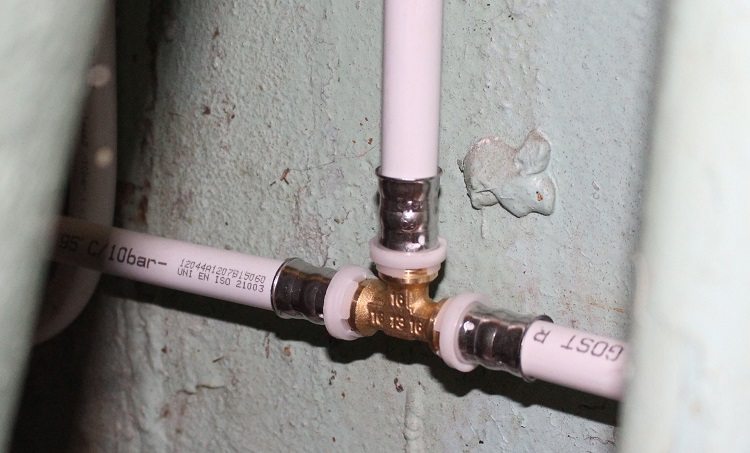
Each pipe passes the marking procedure - data on the technical parameters are applied to the product
Standard product information includes:
- logo of the company that produced the pipe;
- certificate in accordance with which the production is performed;
- material;
- stitching method;
- pressure rating in bar;
- media that can be transported through the pipe;
- date, party.
As the material, polypropylene - PP-R, polyethylene - PE-R or cross-linked polyethylene - PE-X can be used. Crosslinking can be performed by several methods: pyroxide (a), silane (b), using a stream of directed particles - electrons (c), nitrogen compound (d).
Note! A constant pressure is called nominal at which the product can last half a century.
It is highly advisable, when performing installation work, to leave the marking noticeable so that if necessary it is possible to determine the type of installed pipes.
Indisputable advantages over analogues, favorable indicators of a technical and operational nature make it possible to determine that metal-plastic pipes are the best solutions for organizing a hot and cold water pipeline, as well as a gas transportation network.
